Armstrong Whitworth Whitley, P5045, Galway Bay, March 1941
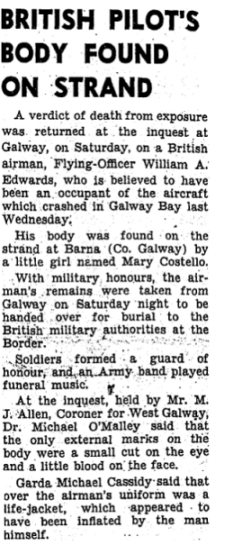 On the night of March 11th/12th 1941, the
crew of a Whitley patrol bomber from 502 Squadron, Royal Air
Force's (RAF), based at Limavady airfield in County Derry,
Northern Ireland, found themselves in difficulty after a long
range convoy escort mission over the Atlantic.
On the night of March 11th/12th 1941, the
crew of a Whitley patrol bomber from 502 Squadron, Royal Air
Force's (RAF), based at Limavady airfield in County Derry,
Northern Ireland, found themselves in difficulty after a long
range convoy escort mission over the Atlantic.
The Captain of the aircraft, young Pilot Officer Edward Dudley
Dear was forced to order his crew to bail out over Galway Bay.
Of the five young airmen on the aircraft, only two would survive
to the morning. The remaining three were lost either with the
aircraft or drowned upon landing. It was one of six
aircraft lost or damaged with the Squadron that month alone.
The aircraft was an Armstrong Whitworth Whitley, a pre-war twin
engine bomber that was being relegated to the over water patrol
role due to its unsuitability to bombing activities over Europe.
This particular aircraft was the Mark V version, powered by two
of the famous Rolls Royce Merlin engines. And it was the
aircraft's engines that proved to be its demise on that night in
1941. This was one of four Whitley aircraft to crash in or
close off the shores of neutral Ireland during the early part of
the war. 502 Squadron lost three men in similar circumstances in
January of 1941 off Donegal, and another thankfully non fatal
accident befell the squadron on 30th April 1941. Indeed,
on the same night as the loss of P5045, Whitley H, T42222 of 502
Squadron was ditched at sea between Fanad and Malin Head, but
the crew were at least rescued by a passing merchant
vessel. P/O Dear had flown that very aircraft the day
before on a short patrol that was abandoned owing to failure of
W/T. A third Whitley that night suffered the loss of an
engine but was able to land without loss to the crew.
The crew of the aircraft were the five airmen listed below:
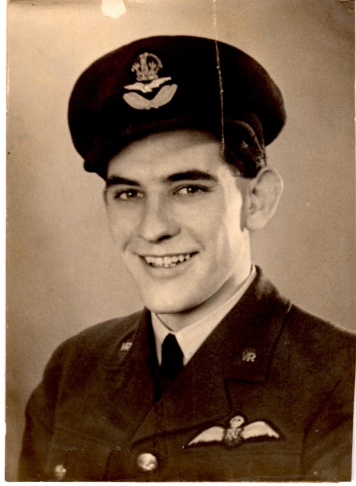 The aircraft's pilot, P/O Edward D Dear
82695, was born on the 5th October 1915 in Croyden,
London. His parents were Christine and Dudley Dear. The memorial
publication, Croyden and the Second World War, published in
1949, records his residence as 6 Colchester Villas, Stanley Road
and that he attended school at Selhurst Grammer School. He was a
member of the Old Croydonians Rugby team in 1937-1939. He was
married to Vera Ward in the summer of 1940 in Camberwell. Teddy,
as he was known to friends, was posted missing following the
loss of Whitley P5045. His remains were never recovered and his
name is recorded on the Runnymede memorial.
The aircraft's pilot, P/O Edward D Dear
82695, was born on the 5th October 1915 in Croyden,
London. His parents were Christine and Dudley Dear. The memorial
publication, Croyden and the Second World War, published in
1949, records his residence as 6 Colchester Villas, Stanley Road
and that he attended school at Selhurst Grammer School. He was a
member of the Old Croydonians Rugby team in 1937-1939. He was
married to Vera Ward in the summer of 1940 in Camberwell. Teddy,
as he was known to friends, was posted missing following the
loss of Whitley P5045. His remains were never recovered and his
name is recorded on the Runnymede memorial.

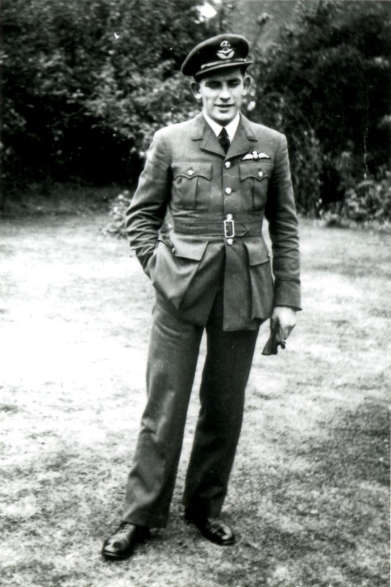
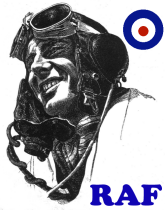 P/O
William Hotchkiss Edwards 81033 was the second pilot on
the aircraft and came from the town of Meole Brace, in
Shrewsbury. His parents were Ada and William Hotchiss
Edwards and had married in 1909 in the Wolverhampton district
with his mothers maiden name being Saunders. William was
born on the 21st June 1918 in the Wem district of Shropshire.
His CWGC register entry records that he was a member of the
Royal Aeronautical Society (RAeS) and their member ship card
shows that he joined the RAeS in February 1938 whilst studying
at Chelsea College. The address given at that time was an
address on Belle Vue Road, Shrewsbury, where William is found on
the 1939 register with this parents. The address details given
in his National Probate Calender is The Rocks, Meole Brace, with
all his estate left to his father, a retired bank manager.
P/O
William Hotchkiss Edwards 81033 was the second pilot on
the aircraft and came from the town of Meole Brace, in
Shrewsbury. His parents were Ada and William Hotchiss
Edwards and had married in 1909 in the Wolverhampton district
with his mothers maiden name being Saunders. William was
born on the 21st June 1918 in the Wem district of Shropshire.
His CWGC register entry records that he was a member of the
Royal Aeronautical Society (RAeS) and their member ship card
shows that he joined the RAeS in February 1938 whilst studying
at Chelsea College. The address given at that time was an
address on Belle Vue Road, Shrewsbury, where William is found on
the 1939 register with this parents. The address details given
in his National Probate Calender is The Rocks, Meole Brace, with
all his estate left to his father, a retired bank manager.
His remains were prepared in Galway by the Irish Army and
driven to the border at Belcoo. The cortege was delayed
owing to the courtesy's awarded to the young mans remains on its
journey but the RAF authorities were so impressed that they
asked that the Irish government be thanked for their
efforts.
William is buried with his parents in Shrewsbury General
Cemetery in a family grave. His father passed away in 1952 and
his mother in 1957. They are in a family plot and thus there is
no Commonwealth War Graves Commission headstone. His
fathers death notice in 1952 mentioned him being the father of
Marjorie, George and Billy.
In the immediate aftermath of the crash, letters to William's
family provided D A E Midgely's name as a contact they could
communicate with.
Oddly, his name appeared printed in a number of UK newspapers
on and around the 16 and 17 March 1941, in newspaper articles
usually stating:
EIRE HONOURS RAF CRASH VICTIM Flying
Officer William Edwards of the RAF whose plano crashed into
Galway Bay, Eire on Wednesday was accorded full military
honours when the coffin left Galway on Saturday on its
journey to the Northern Ireland border There it will be
handed over to the British authorities At the inquest
earlier in the day a verdict of 'Death from exposure was
recorded' Flying Officer Edwards was believed to have been
the only occupant of the plane His body was found by a
little girl on the sand at Barna.
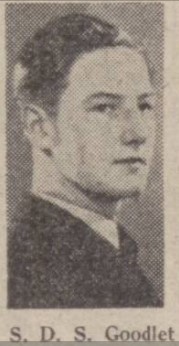 No
relatives of Sgt Stanley David Sutherland Goodlet,
973901, have been traced at this time. He was son of David Bell
Goodlet and Jessie Jane Goodlet and was born on the 20 May, 1920
in Edinburgh. His father was a Great War veteran of the
Royal Engineers and in 1941 was serving as a Sergeant in the
248/249 Coastal Battery of the Royal Artillery. A short
notice of his death was published on 24th May 1941 in the
Edinburgh Evening News, accompanied by a small portrait photo.
No
relatives of Sgt Stanley David Sutherland Goodlet,
973901, have been traced at this time. He was son of David Bell
Goodlet and Jessie Jane Goodlet and was born on the 20 May, 1920
in Edinburgh. His father was a Great War veteran of the
Royal Engineers and in 1941 was serving as a Sergeant in the
248/249 Coastal Battery of the Royal Artillery. A short
notice of his death was published on 24th May 1941 in the
Edinburgh Evening News, accompanied by a small portrait photo.
Stanley was at one time commemorated in Galway following the
recovery of a set of remains near Cranmore on 14 April
1941. On the body the only items of identification found
were a wrist watch, a shirt tie and the collar of a shirt.
Despite much correspondence however between the Irish and UK
authorities it was determined in 1953 that the remains could not
be firmly identified as those of Stanley. His father was
only informed in 1953 that remains, believed to be that of his
son were buried in Galway twelve years previously, but following
the review of matters, it could no longer be determined that the
remains found actually were Stanley. Thus the grave was
marked as an Airman, Known unto God"
As late as may 1977 the death notice of his mother recorded she
was "mother of the late Stanley".
There does not seem to have been any siblings.
The two survivors, Sergeants Harkell and Midgley remained in
internment until October 1943 when they both were released in
the first Allied batch of airmen to be officially, but
quietly, released by the Irish authorities. They arrived in
Stranraer on October 19th, 1943. They filed two very short
escape and evasion reports which are now in the UK National
Archives. P/O Midgley's statement, which is referred to in Sgt
Harkell's report, states simply:
1. Internment.
Whilst on convoy escort duty, S.W. of EIRE on 12 Mar
1941 our port propeller broke. We were trying to make our
own ground in NORTHERN IRELAND when the starboard engine
failed and we were ordered to jump.
I came down in GALWAY BAY and swam ashore, and the
following day was interned in THE CURRAGH CAMP.
Escape Attempts
In the two escape attempts of Feb and Aug 1942 I was
not successful in getting out of the camp.
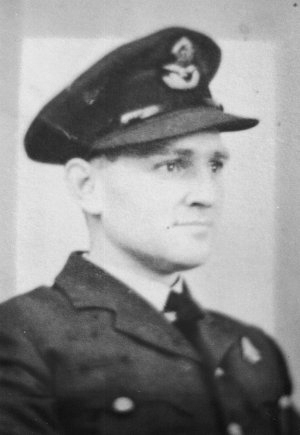 P/O David Arnold Eric
Midgley 60328 (Observer/Navigator) was born in 1913 to
Emile and Horace Midgley.
P/O David Arnold Eric
Midgley 60328 (Observer/Navigator) was born in 1913 to
Emile and Horace Midgley.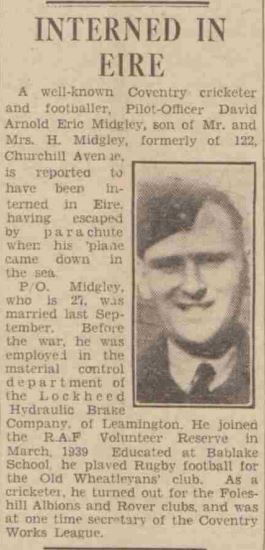
He gave his profession as production engineer and had joined the
RAF in April 1939. The Coventry Evening Telegraph of 20
Mar 1941 published the following article after his
internment:
INTERNED IN EIRE
A well-known Coventry cricketer and footballer,
Pilot-Officer David Arnold Eric Midgley, son of Mr. and Mrs.
H. Midgley, formerly of 122, Churchill Avenue, is reported
to have been interned in Eire, having escaped by parachute
when his 'plane came down in the sea.
Midgley, who is 27, was married last
September. Before the war, he was employed in the material
control department of the Lockheed Hydraulic Brake Company,
of Leamington. He joined the R.A.F Volunteer Reserve in
March, 1939. Educated at Bablake School, he played
Rugby football for the Old Wheatleyans' club. As a
cricketer, he turned out for the Foleshill Albions and Rover
clubs, and was at one time secretary of the Coventry Works
League.
Following his release, the now promoted Flight Lieutenant David Midgley returned to active duty and in late 1944 joined number 201 Squadron flying Sunderland flying boats out of the base at Lough Erne in Northern Ireland.
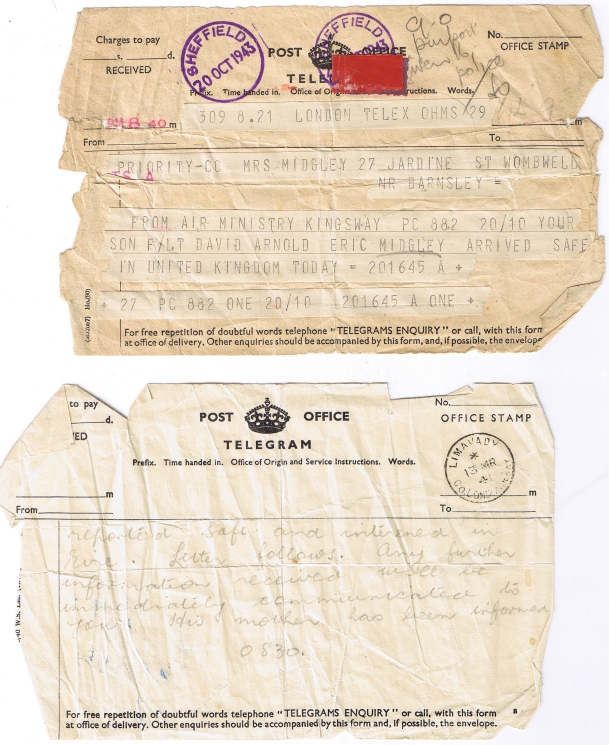
His family were able to provide the above scans of telegrams received by his late mother during his internment in Ireland. The upper one reports to her that he has returned to England in October 1943, and the lower telegram, sent in March 1941 states - Reported safe and interned in Eire . Letter follows. Any further information received will be immediately communicated to you. His mother has been informed.
He remained in the RAF after the war, transferring from the RAF Volunteer Reserve to the RAF in 1949. He later transferred to the Equipment Branch and retired with the rank of Squadron Leader in 1961. David passed away in Oxford on the 14th October 1965 aged just 51, leaving his widow Rudy behind.
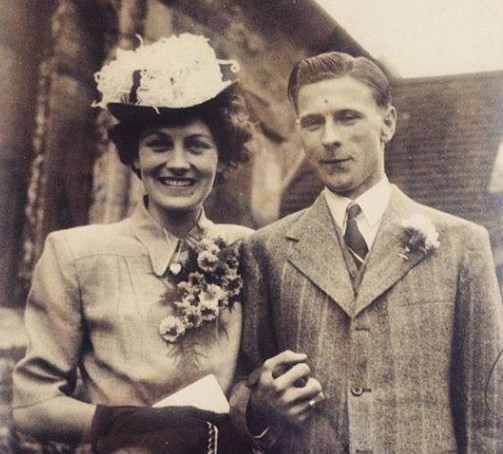 Robert Harkell was born in Rugby in October 1919
to Lilian and Walter Harkell.
Robert Harkell was born in Rugby in October 1919
to Lilian and Walter Harkell.
After the war Sgt Robert G Harkell 749495 (Wireless
Operator/Air Gunner) became a a consulting engineer and traveled
throughout much of the world. He was the son of Lillian and
Walter Harkell from Market Harorough, Leicestershire.
The Leicester Evening Mail on January 16, 1942, published the
following short article:
INTERNED IN EIRE Sgt Robert Harkell, of
Lathkill street, Market Harborough, who is in the RAF and is
now an internee in Eire, states in letters to his parents he
is very well looked after and that German internees there
receive similar treatment. He Is allowed to wear civilian
clothes, and providing they attend parole, the men are free
for the remainder of the day.
His brother Bill made contact in 2012 to tell of what he knew
about his brothers time. In 1946, Bill visited Athy in Kildare
to stay with a family who had been friends with Robert during
his time interned in Ireland. Bill provided the below account of
his brother's time in internment and it is interesting to note
the story of the 'escape' from Ireland. This is a common theme
among the families of some of the internees. It would appear
that a story arose after their release that they had escaped in
the strange fashions they described. The files in the Irish
Military Archives and the Irish and UK National Archives however
tell a different and much more mundane story. The men in October
1943 were simply driven to the border with Northern Ireland and
released to the authorities there. The airmen would have been
sworn to the utmost secrecy at the time so it is understandable
that the story arose. We will let Bill tell his brother story in
any case:
My brother, Robert (Bob) Harkell,
joined the RAF at the beginning of WWII and trained to
become a Wireless Operator/AirGunner. He was a perfectionist
and extremely fast and accurate with Morse Code.
In the RAF he flew missions with Coastal Command over the
Atlantic protecting the military and civilian convoys
sailing from the USA to England from the Nazi U-Boats. On
one such mission the Whitley bomber had engine failure and
according to one report had a propeller break on the other
engine. They had to bail out and my brother landed near
Galway Bay. In the landing he injured an ankle and was soon
picked up by local police who contacted the Irish military
authorities.
Eire was a neutral country and interned military personnel
from both the Allies and the Axis powers. The internment
camp was at the Curragh in County Kildare.
Ironically, I’ve since discovered on Google that the camp
was originally built by the British to house Irishmen
captured during Irish protests against British rule. I
believe it was called the A-Lines while under British
control.
It is the duty of a prisoner of war to try to escape and
there were several attempts made that involved my brother.
In one attempt I understand he was to act drunk and distract
the guards while other prisoners tried to escape. Another
escape was planned by tunneling under the barbed wire fences
but that attempt was discovered, too.
In the 1940’s Roman Catholics and Protestants were very
intolerant of one another. It is my understanding that
anyone escaping from Curragh Camp had to choose the escape
route that was safe for his religious affiliation. Bob was a
Protestant so tried to escape along the Protestant route to
Ulster.
My brother was helped by a Protestant family who had a farm
near Athy. Their name was Kenny or Kenney.
On New Year’s Eve, 1946, my sister and I took the ferry from
Holyhead to Dún Laoghaire to thank the Kenney family for the
help they gave to my brother. It was a very rough crossing.
It was a very exciting trip for me. I was a 15 year old
English Protestant going to a land where I knew the Brits
were hated. (I understand why, too!)
We had a wonderful time on the Kenney farm but the highlight
was riding into Athy in a trap drawn by a horse named
Dahlia. That was 66 years ago and I still remember it very
fondly. Eire is a beautiful country. It truly is the Emerald
Isle.
After the RAF my brother returned to civilian life and
became a consulting engineer to steel related companies and
in 1948 married. He and Kay had 3 daughters.
His work was global in nature and he traveled extensively
including stints in Europe and Canada. Two of his
assignments included extended stays in Osaka, Japan and
Cleveland, Ohio USA.
In 1997, during a celebration of their 50th wedding
anniversary, Bob complained to me about chest pain. I have
coronary artery disease so Bob wondered if his pain might be
angina. Unfortunately, upon investigation, it was much
worse.
Bob’s work in the many steel factories where air quality
including considerable quantities of asbestos dust was as
yet uncontrolled, made him a prime candidate for
mesothilioma, a specific cancer in the lungs. He was
diagnosed and died within a year. My wife(Mary) and I, flew
over to visit him, but by then Bob was being moved into
hospice. He died shortly after our visit.
Robert married after the war. His wife, Kay, was herself
the widow of an RAF Bomber Command officer, the two having had a
tragically short marriage of only a few weeks before his death
over Germany. Robert's grand-daughters were able to
provide the following group photo which appears to show some of
the British internees. The two men standing at the right
hand rear of the photo in civilian attire were identified by
Reggie Darling, who grew up in the Curragh area, as Alex Lyons
on the left with Ernie Lyons to the right. Ernie was a champion
TT Rider in the 1930s and his brother was also involved. Reggie
understands that the photo was taken on the day of the marriage
of Eileen Lewis to Canadian internee, Roswell F Tees.
Eileen's father, Jack Lewis, was the manager of the Wesleyn Home
in the Curragh Camp (a recreation centre and canteen).
Reggie could not identify the 3rd civilian in the middle of the
back row. Alex and Ernie came from Kill Co. Kildare and in fact
Ernie only died on 07 Feb 2014 aged 100 years.. Those
faces that can be identified are believed to be:
In the front row of the photo, from left to right
Sgt Robert George HARKELL 749495
Sgt Norman Vyner TODD 551678
Sgt William BARNETT 973926
Sgt David SUTHERLAND 51946
It seems most likely that the tall man standing at the very left
of the photo is Sgt Herbert Wain RICKETTS 581473.
The airman with the light coloured hair standing at the middle
is Sgt George Victor JEFFERSON 816145
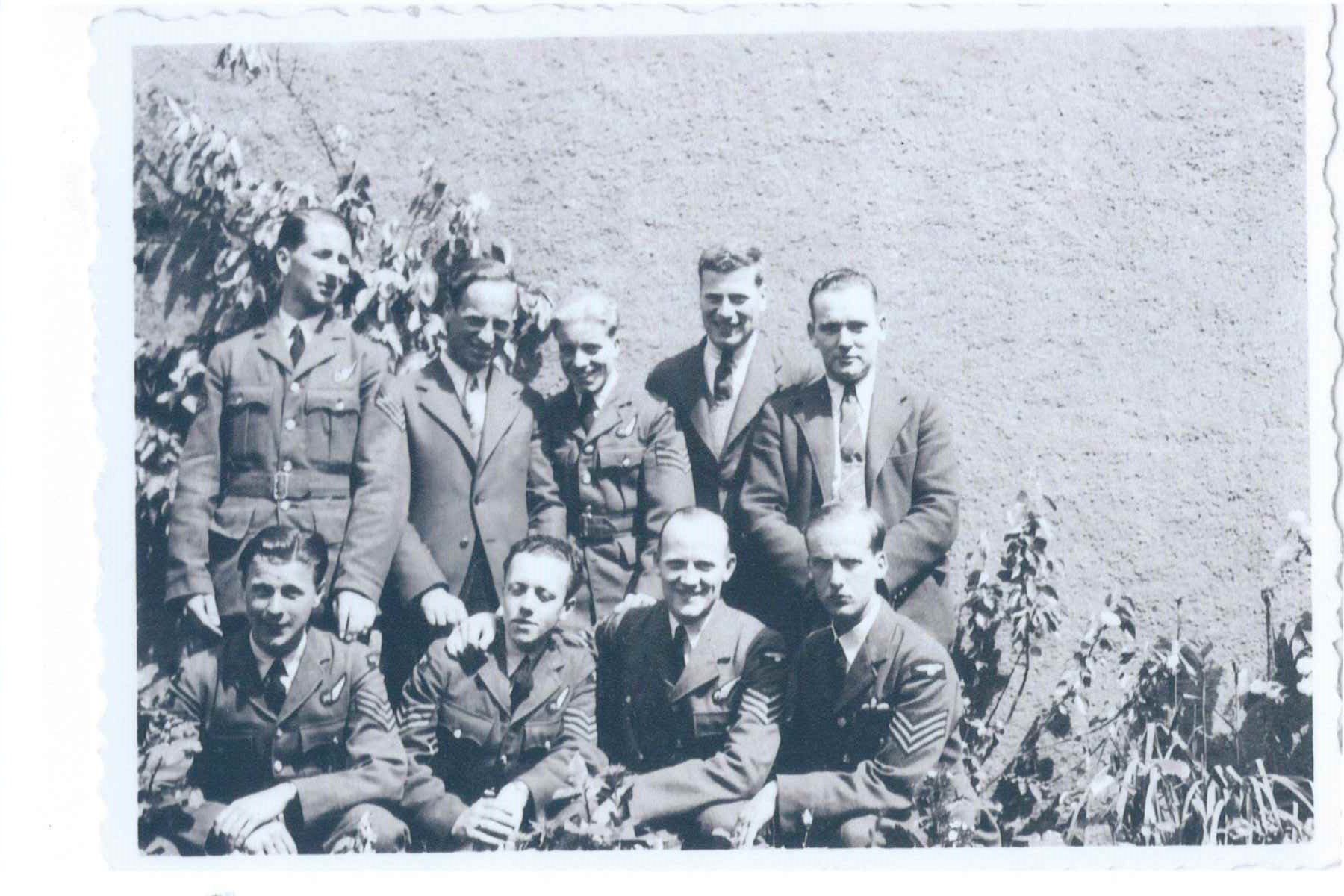
Also among Robert's photos and records were these images taken
of him and of the Curragh internment camp.
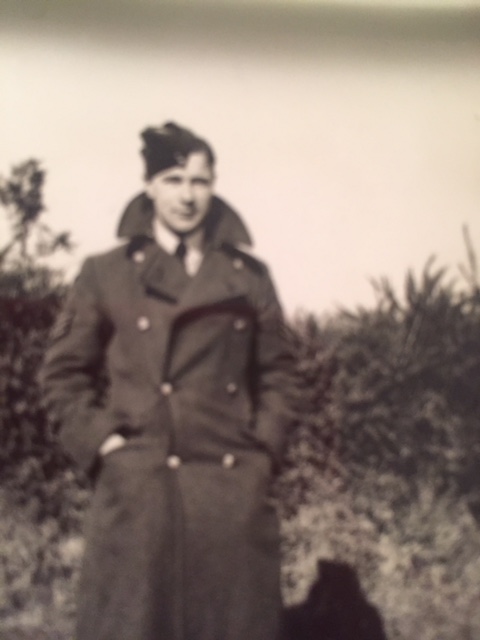 |
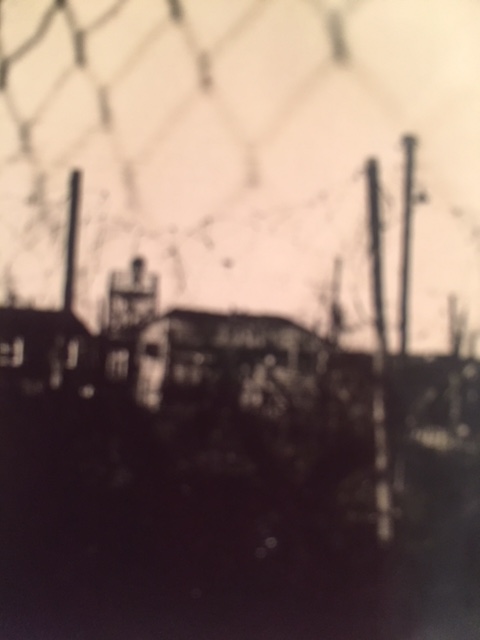 |
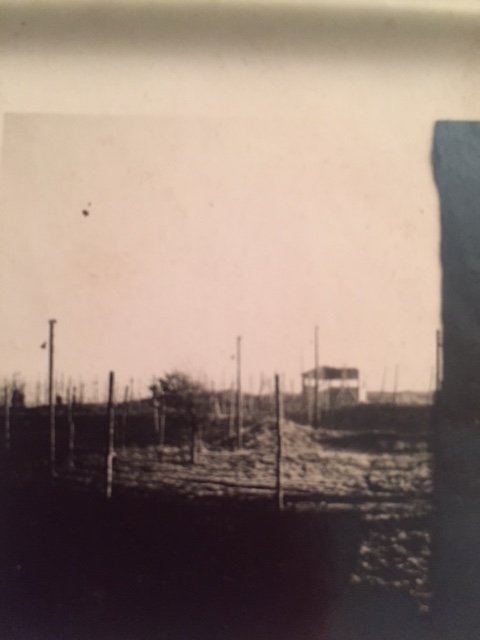 |
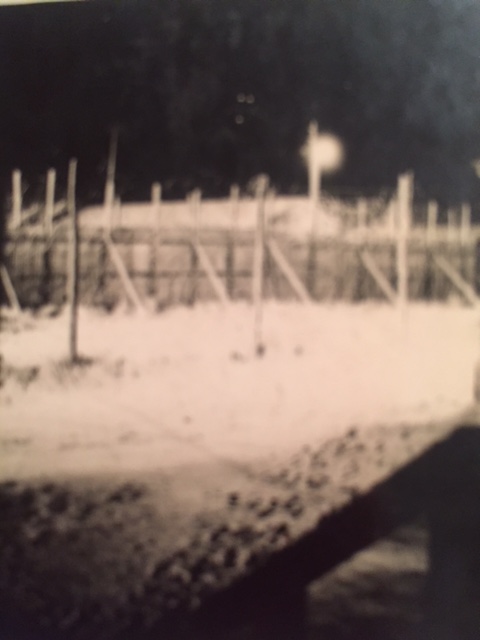 |
Around 1962, Robert Harkell was in correspondence with Galway
man Leo Sheridan, mentioned below, and provided the following
recollections to Leo.
"On the night in question, we were obliged to abandon the aircraft due to severe mechanical trouble which was tearing the starboard engine out of the wing, causing tremendous vibration and causing smoke to enter the fuselage. I believe that we were above cloud, unaware of the presence of town below and flying towards the north (probably west of north). We had previously been flying east of south and had turned on reciprocal. I cannot remember what length of time had passed between turning and running into mechanical trouble, nor do I know whether a steady course was being flown during the period of this trouble until we baled out. The pilot was certainly fighting to gain height and it has always been my clear impression that he mentioned that we had 5,000 ft as our height when jumping commenced. Of the crew of five, only the first and third man out survived; being the third man, no survivor left after I did, and therefore no one can say what happened afterwards.
Having said that I can give no proof, let me at once say that I believe that your main theory could well be correct, for the following reasons.
Firstly, the man himself. Although I knew him little, for I was flying as a replacement airgunner on this particular flight and was not a regular member of F/O Dear’s crew, he struck me without question as the type who would, in the circumstances, do as you believe he did. Secondly, we had on board, a large depth charge which had not been jettisoned due to our knowledge that we were over land. Thirdly, and most important of all, that our Captain presumably went down with the Whitley, since his body was never recovered. In view of our original height and certainly of the length of time during which I was able to hear the aircraft still flying after I left it, there should have been ample time for both pilots to have jumped clear. (Whilst in interned at the Curragh camp I learned that the Captain had not been found and could not understand the reason in view of the adequate time available for jumping)."
Robert George Harkell died in August 1998 in Warwickshire.
The story of Whitley P5045 has stayed alive in the minds of people in Galway ever since the war. As early as the some witnesses were calling for a memorial to be raised to the crew. At this stage it was being claimed that the F/O Dear had selflessly stayed with the aircraft to steer it away from Galway and Salthill. In the early 1990's one Leo Sheridan campaigned to have the wreckage found so that the weapons the aircraft carried could be made safe for shipping outside Galway. Mr. Sheridan was involved in a company who hoped to run a tourist submarine service in Galway Bay.
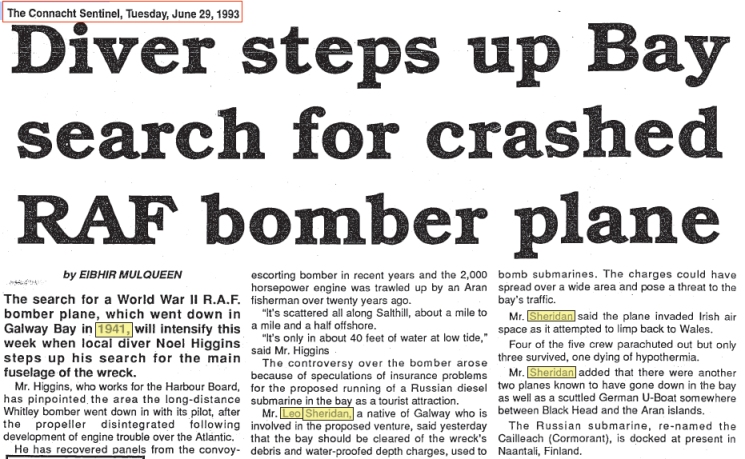
The crash is mentioned occasionally in the local Galway papers
and as late as 2012, there was talk again about raising a
memorial to the pilots on the basis that they had deliberately
avoided crashing into Galway with the depth charge laden
aircraft. Review of the limited wartime statements don't
indicate that the pilots were doing this. It is felt that
witnesses to the aircraft in its final minutes felt that the
crew were avoiding built up areas. The two survivors made no
observations of that nature and sadly the pilots perished in the
incident. Witnesses also believed they heard an explosion after
the crash which might have been the sound of the aircraft's
weapons detonating, but again, this is only assumption. What
ever the truth might be behind the actions of the pilots in
those last few minutes, it is certain that three young airmen
lost their lives in a tragic accident. Hayden Lawford, who
passed away in 2013, sent on his findings from the review of the
Operations Record Book for 502 Squadron. This is held in the UK
national Archives in Kew, London:
Interestingly enough the 502 Sqdn ORB
indicates that at the time there were problems with the
props on the Whitley - there had been one ditching and a
return to base with prop problems on 11th March. It is
possibly significant that at 12.25 on 12th all 502 Sqdn
aircraft were grounded and 3 aircraft sent to Staverton for
prop changes, no further ops were undertaken by 502 for the
rest of March 1941.
I have checked up on the Convoy situation on the evening of
11th March, and P5045 may have been patrolling out as far as
54N 16W, almost 300nm west of Galway, to escort an outbound
convoy, OG55, so fuel could have been low as they would have
been airborne for over 9 hours if the crash occured around
02.30 on the 12th March as quoted, but I am not sure what
the endurance of a Whitley would be on this type of patrol.
Also they had a head wind on the return leg as the surface
winds were moderate ESE. The official RAF crash report
states:
"The aircraft was misdirected by a series of H/F and D/F
bearings and so became completely lost. The aircraft was
at a reasonable height (4000’ or so), bearings were
unreliable up to 120 degrees in error. H/F - D/F
bearings are still very unreliable.”
The H/F D/F referred to the High Frequency Direction Finding
system the crew relied upon. This equipment was intended to show
the operator the direction from which a radio signal was being
broadcast.
The ORB for 502 Squadron recorded the following narrative of
the mission:
Take off time: 1658
0051 Aldergrove received SOS believed from Whitley
O/502.
0120 Aldergrove confirm SOS.QDM 165. Arrange with them
to start scheme B.
0028 Aldergrove report Hudson W/206 circling estimated
position.
0247 asked Newtonards to call O/502 on MF/DF.
0258 over due action.
0310 passed particulars for Aldergrove to transmit on
F.O.6.D.
1145 informed by Limavady police that crew had landed at
Galway.
1215 Galway police reported P/O Midgley and Sgt. Harkell
interned in Irish Free State. P/O Edwards body brought
to Limavady by Ambulance and sent to Shrewsbury for military
funeral.
F.O.6D referred to the procedure of contacting the Air Ministry
to report an aircraft was an hour overdue. M/F D/F
referred to another system, the Medium Frequency Direction
Finding apparatus.
The Whitley joined the RAF in 1937, but by the time the war
began it was out classed as a bomber and as soon as they could
be made available they were transferred to RAF Coastal Command
for convoy protection and anti submarine work. Whitley P5045 was
a Whitley V version, powered by two Rolls Royce Merlin X
engines. A brief run down of the type is given in the profile
below from the December 3rd, 1942 edition of the magazine,
Flight. These archive magazines can be found on
www.flightglobal.com.
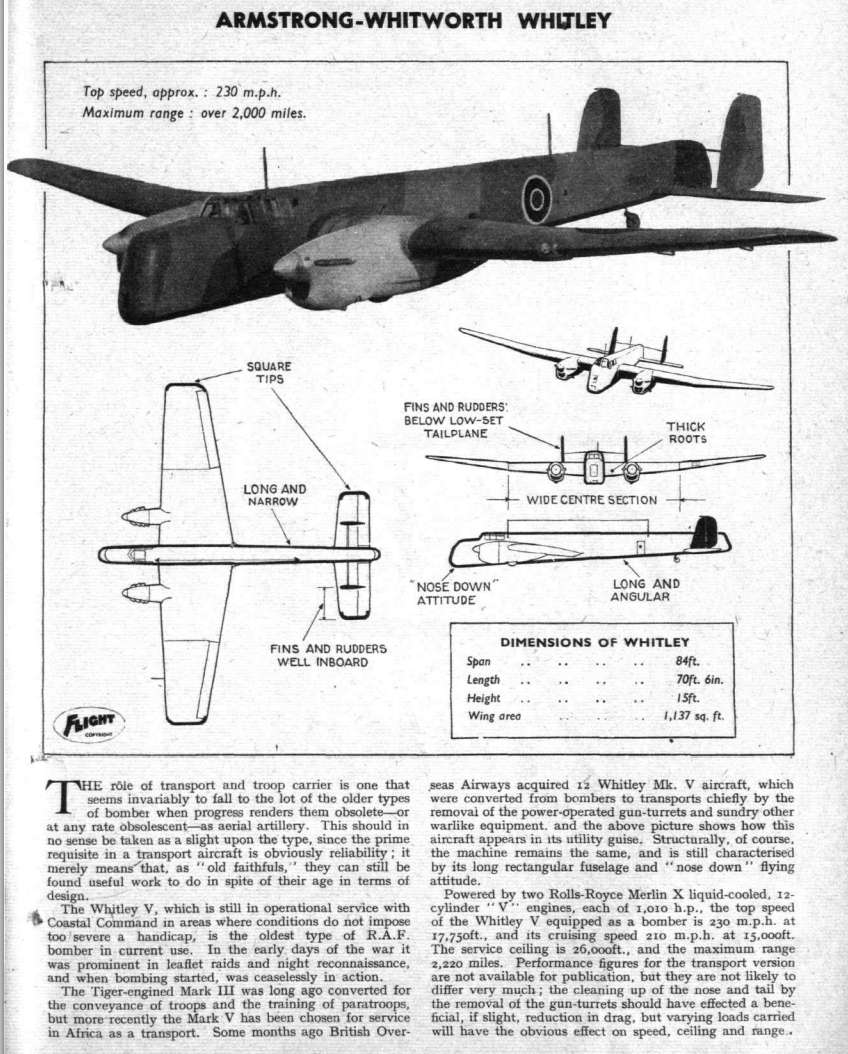
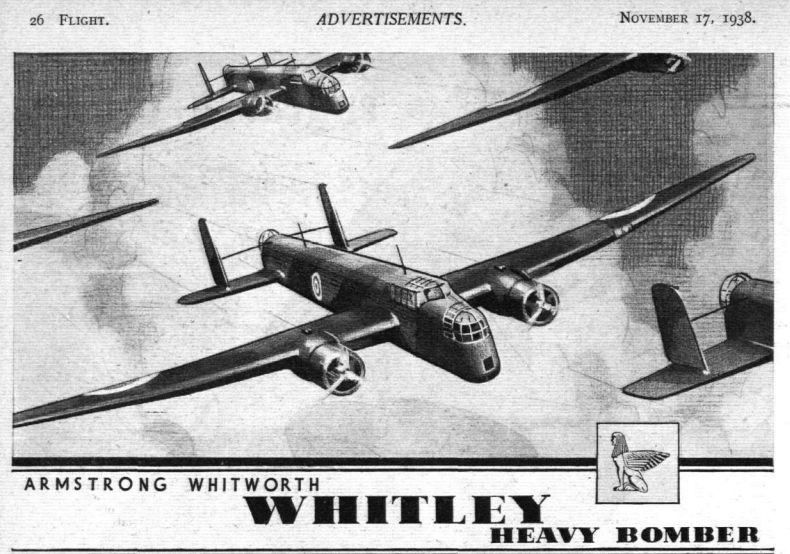
Compiled by Dennis Burke, 2023, Dublin and Sligo. A big thank you to the Dear, Harkell and Midgley families, to Martin Gleeson and to the late Hayden Lawford who passed away in 2013. Also to James Keating of Galway.
